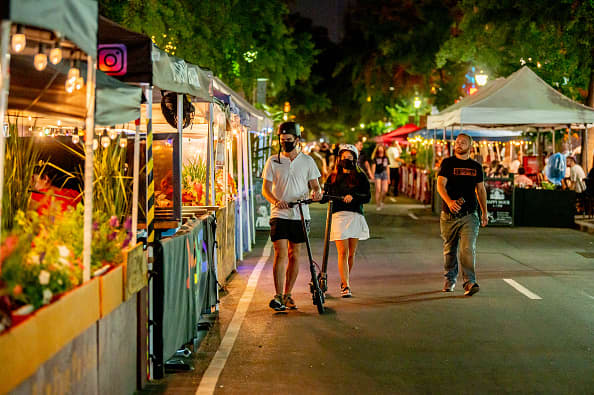As states lift restaurant restrictions, CDC report links dining out to increased Covid-19 risk

Two people with scooters wear masks walk down 46th Street which has been temporarily converted to “Restaurant Row” for outdoor dining during the fourth phase of the coronavirus pandemic reopening on September 06, 2020 in New York, New York.
Roy Rochlin | Getty Images
Dining out raises the risk of contracting Covid-19 more than other activities, such as shopping or going to a salon, according to a report published Thursday by the Centers for Disease Control and Prevention.
The findings come as many states consider the safest ways to reopen businesses, especially restaurants. On Wednesday, for example, New York Gov. Andrew Cuomo announced that limited indoor dining will be allowed in New York City starting Sept. 30.
The CDC report included 314 people who had Covid-19 symptoms and were subsequently tested for the virus; about half tested positive.
Researchers then asked all participants about their social activities during the two weeks prior to their Covid-19 test. The participants lived in states with varying levels of reopening guidelines: California, Colorado, Maryland, Massachusetts, Minnesota, North Carolina, Ohio, Tennessee, Utah and Washington.
Both groups generally reported similar activities, such as going to church, gyms and stores, with one exception: going out to eat or having drinks at a bar or coffee shop.
Those who tested positive for SARS-CoV-2, the virus that causes Covid-19, “were approximately twice as likely to have reported dining at a restaurant than were those with negative SARS-CoV-2 test results,” the study authors wrote. And those who were diagnosed without any known exposure to the virus were more likely to report having visited a bar or coffee shop in the previous two weeks.
The increased risk makes sense; it’s easy to wear a mask in stores or in places of worship, but it’s nearly impossible to do so while eating and drinking, said Dr. Todd Rice, a co-author of the report and an associate professor of medicine at Vanderbilt University Medical Center.
In addition to being maskless, individuals are often close together when eating at a restaurant, sitting across the table from one another.
“If people are going to eat out, they need to be thoughtful about how they’re going to do it,” said Rice, who lives in Nashville where restaurants are operating at 50 percent capacity.
He said he has absolutely gone out to eat within the past six months, but takes several precautions.
“Even if I’m sitting at a table and the food hasn’t arrived yet, I still wear a mask. I won’t sit at a table that’s next to somebody else,” Rice said, adding that he also asks to be seated outside.
One limitation of the report is that the researchers did not ask participants whether they ate or drank indoors or outdoors.
Infectious disease experts maintain that outdoor spaces are safer than indoor areas, which have less ventilation. The CDC’s guidelines for dining out indicate that drive-thrus, delivery, take-out and curbside pick-up carry the lowest risk for Covid-19 transmission.




